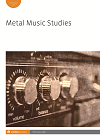
Full text loading...

Metal music has a signifying visual aesthetic or so-called visual code. In this article, I examine the significance of four primitive visual properties that characterize the code. I propose that the propensity for visual artefacts of metal music to depict low luminance, low colourfulness, redness and angular shapes is because these properties can act as subtle threat cues. As metal music has a preoccupation with threatening themes and sounds, these four properties provide concordant visual information about the affective attributes of the genre. After reviewing the supporting psychological evidence, I conduct a quantitative test of this proposal by comparing album covers from extreme metal bands to those from children’s music, two genres that are opposed to one another in their embrace of a threatening atmosphere. The results indicate that extreme metal album covers are darker, less colourful, redder and feature more angular shapes compared with their children’s counterparts, which suggests that these properties are relied upon to communicate a clear threat signal.

Article metrics loading...

Full text loading...
References


Data & Media loading...

Publication Date:
https://doi.org/10.1386/mms_00075_1 Published content will be available immediately after check-out or when it is released in case of a pre-order. Please make sure to be logged in to see all available purchase options.